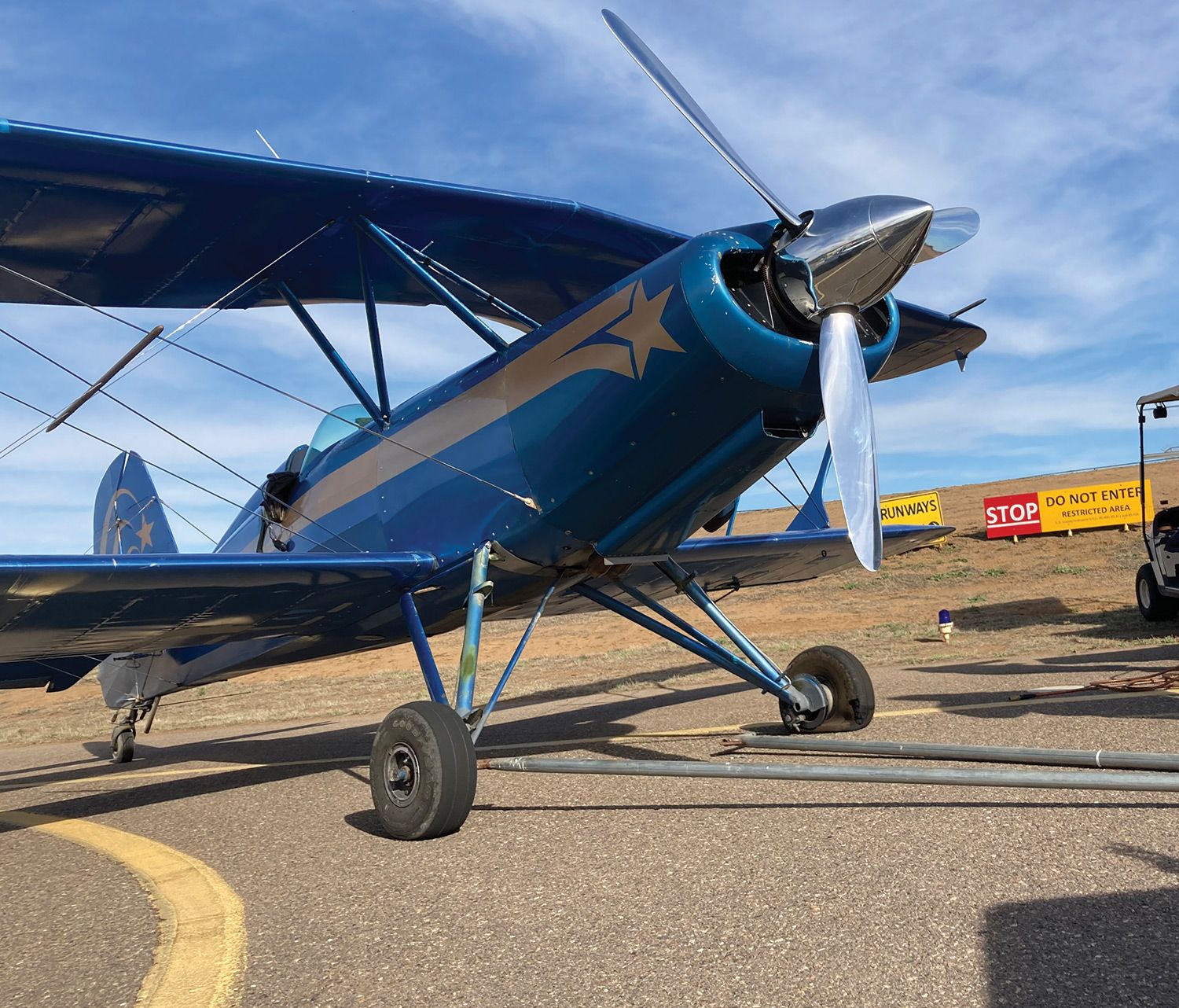
It was just two days before standing down for an annual inspection, so I thought to take the ol’ box kite out for a little exercise. Thanks to ensuring my COVID resistance the hard way and other distractions, I had not flown much lately and needed a walk around the yard myself. A few easy turns and stalls later, I returned to the pattern to see what I could do with the rare north wind blowing that day and the resulting “backward” operations at our single-runway flying place.
Not much, as it turns out. Clearly exhibiting the rusty skills and judgment expected of an amateur playing at a professional endeavor, I lightly skipped the biplane off the pavement a couple of times before jiggling the seismographs with a real doozy on the third lap.
Why is it always the third or so landing in a series that’s horrible? Lack of ability to focus that long, no doubt. In any event, I couldn’t let it go at that and, having planned on making four circuits, set off for another trip around the patch. Now well-motivated to demonstrate at least some skill, I managed a nice approach and smooth return to earth. Better.
There’s a small heave or bump in our runway about midfield and as we rolled over it, tail still held high, “she made a move to the left” as the drag boys would say. Odd. A quick, authoritative but small application of right rudder took care of that, but I couldn’t help but notice we were tending to the left on our slow roll down to the turnoff. Once at the taxiway—which resembles the start of a miniature ski jump thanks to the hilltop nature of our airport—I further noticed the Starduster rolled politely around the turn and down the hill without picking up hardly any speed. Another odd. Plus, a couple hundred feet down the now-level taxiway, and cognizant I was even ambling downwind, I had to add power just to keep rolling when reality final got between my ears and I realized I had a low and getting lower tire somewhere in my triangle of rolling stock. Having put the tailwheel tire flat several times in earlier years, I first thought it might have gone again, but by the time I had shut off, shrugged away the harness and pushed myself up and out of the cockpit, I knew it was the left main.
And so it was, beads off the rim and all. Of course this was on a Saturday afternoon, so I was providing the entertainment for vulture’s row. Not my favorite pastime, but it did mean help was immediate. Going with the motto easiest is best, an A&P with a handy mobile cart gave the tire a shot of air. It was quickly apparent the valve stem was compromised at its base, but the ailing tube would hold air long enough to get the airplane down to my hangar. As by then I had already brought up the big tow bar, I simply towed the airplane behind a pickup to my hangar and that was the end of the show for my friends. But it was just the beginning of trying to figure out the how and why of the failure, contemplate my continuing good luck—I didn’t land with a completely flat tire and wad the works up into a spruce and chrome- moly porcupine ball—and figure out how best to proceed.
I hadn’t planned on having to remove a wheel and tire assembly and thus immobilize the blue beast in the hangar when I went flying that day. But the sun was getting low, so step one was to get a short stack of stabilizing wood and metal under the left gear so the tire wouldn’t be squished until I could get back to this new job.
That done, I managed a quick stop by the internet to see if the replacement parts were available (yes) and how much they were going to cost. Well, at least both of my sons are past college age, so I wouldn’t feel much guilt robbing the family funds, but geez, like everything else, rubber must be coming from heaven these days. Last time around, the box kite got a set of Goodyear Fight Custom III tires—it’s a long story how this penny-pincher ended up with one of the most premium and expensive tires available—and I about swallowed my breath mint when I saw the bill. But I was told I would like those tires and they would last a long time and so on…and they have. So, with the financial pain of that purchase well behind me, I guess I have to admit I have liked these tires. But at over $700 for two replacement tires and tubes, my wallet is beginning to take an abalone tool to open. That said, tired of having to add air to lesser tubes, I’ve got something like a heroin habit for apparently airtight Michelin tubes and they’re pennies short of a C-note apiece.
How Long Do Tires Last?
Even with all the knowledge I’ve gained as a journalist researching and writing for decades about sports car, truck, trailer, race car and now aircraft tires, I decided to see what the life span is for a Flight Custom III. Yes, I know the arguments. The street car tire industry likes to sell tires and says a tire is done after five years and should be replaced if any question or need to repair pops up. That’s awfully aggressive, but that said, things are definitely dicey around the seven-year mark, and if one of my ground vehicles runs more than errands in the local area, it’ll get new skins around the seven-year itch if I haven’t worn them to the nubbins already. Furthermore, a trusted local tire retailer says bargain tires today are good for three years max, while the better tires go far longer.
Trailer tires are especially innocuous until the moment they separate their treads. Unless you’re into daily hauling, trailer tires never wear out from lack of tread depth, and you just have to get used to replacing pretty good-looking trailer tires because they age out. Furthermore, trailer tires often sit for months or more, which denies them the rejuvenating effects of rolling. Turns out flexing a tire’s carcass and tread via rotation promotes the movement of oils in the rubber, which helps keep the tire flexible longer. For sure, a tire left standing gets hard and ready to fail before its time. Ultraviolet light doesn’t help, either.
But airplane tires aren’t car tires, and Flight Custom III tires are premium units, so what say Goodyear? To my surprise Goodyear’s Aircraft Tire Care & Maintenance publication says, “Age is not an indicator of tire serviceability. Goodyear aircraft tires or tubes have no ‘expiration date’ as long as all service criteria (Section 4 of this manual), visual criteria (Section 5), or individual customer-imposed restrictions are met.”
The same passage continues to say, “It is recommended that tubes not be reused; they can grow as much as 25% in service. Reusing them can result in folded, pinched tubes, which can fail or create an imbalance.”
Now, the “no life limit” phrase is under the section on storing tires and therefore might not apply to tires in service. I tried to contact Goodyear for clarification but got no response, so we’re on our own on this one. But wow, age isn’t a factor? Well, at least any normal age, we must presume; I don’t think anyone could logically expect a 30-year-old NOS tire to provide as-new service. As for the service and visual criteria in the manual (Sections 4 and 5), they’re the usual important stuff on how tires are stored (away from chemicals and ozone sources among other things) and the also usual and important lack of tread or sidewall cuts, FOD, underinflation wear, blisters, tread bulges (separation) and so on. It doesn’t say anything about my landings.
My Starduster tires look like they’re a month old. Yes, the tread is worn—evenly—but there is still good tread depth, absolutely no flat spotting or asymmetrical wear and so on. There is no cracking in the tread. They roll regularly; they live in a hangar or even under a wheel pant (usually). But get this—the logbook shows they went on over eight years ago…and I think the tube that failed is a year older yet. Hmm. They’re a premium tire with bulletproof Kevlar in the carcass (well, somewhere in the tire), and I’ll bet they’re about as indestructible as an iron ball as tires go. I sure am tempted to run them some more with new tubes inside. Didn’t say I would, but at over $500 for two tires before I buy the tubes, I sure am tempted.

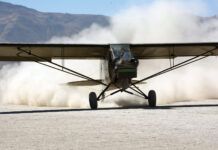
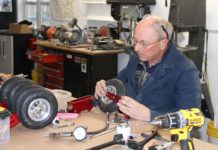
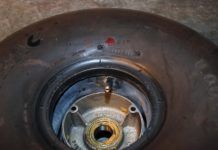
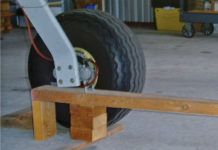
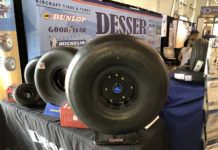
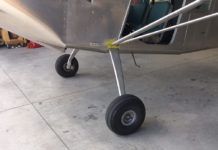
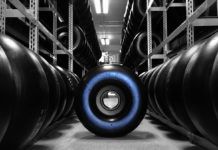

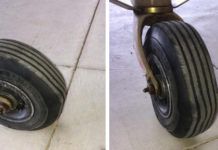

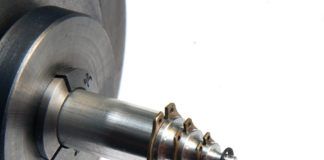
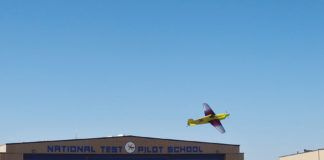
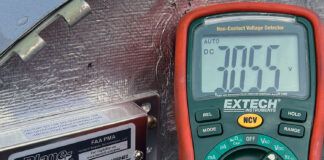
Wow!!! I can see your point.